November 04, 2010
By John Dudley
Prevent Poor Nock Fit from Eroding Your Accuracy.
By John Dudley
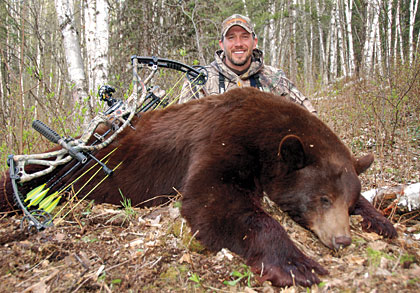 Over many years of competition, professional archer John Dudley has learned that small equipment details such as nock fit can have a big impact on accuracy. By applying the same principles to his hunting gear, he has become a more effective bowhunter. |
One of the most critical considerations on your archery rig is the connection between the arrow and bowstring. This simple click can determine how consistently -- or inconsistently -- your arrows fly. Despite that, most hunters never even consider its importance. I am here to tell you that you are selling yourself short on accuracy if you don't pay attention to your nock fit. In addition, other problems such as your arrow falling off the rest or string are related to improper nock fit. With some basic knowledge, however, you can be confident your arrows will be properly nocked and ready to rock!
Nock Knowledge
There are two sections to an arrow nock -- the groove and the throat. The throat is ever so slightly larger (.012-inch, to be exact) than the groove leading up to it. A nock is designed this way so it can snugly clip onto the string and then have some free space to move on the string serving. This allows the string to remain unrestricted and spin while seated into the throat as you draw and shoot. If your nock fits too tightly, there is no room for this natural movement and the result is poor arrow flight. There is a fine line (only a few thousandths of an inch) between the two. Ultimately, what you want is an arrow that clicks onto the string tight enough that it won't fall off yet loose enough to spin freely during the shot cycle.
Advertisement
An easy way to check this is to nock an arrow on the string and tip the bow down so your point is towards the ground. Then, try rolling the string serving left and right with your fingers. If your serving can spin freely, then your nock fits perfectly. If your arrow moves left and right when you are rolling the string with your fingers, then the nock is too tight. Over many years of testing on my own hunting and professional competition bows, I have come to the conclusion that if the nock fit to the string is too tight, it will reduce accuracy.
Your local pro shop technicians can quickly tell if you have excess serving wear from nocks that are too tight. There will be an obvious flat spot worn on your connection point. This is a sure sign your nocks are much smaller in diameter than the serving on your string. If you notice this on your bow, the simple fix is to re-serve your string with a smaller diameter thread to suit the nocks you are using. If you know how to serve your own string, you may even want to experiment with several types of serving thread to see which one results in the tightest arrow groups.
Advertisement
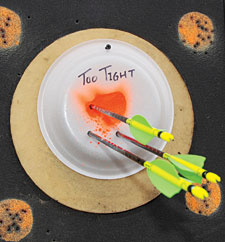 This photo shows the 20-yard arrow group John Dudley shot with nocks that were pinched too tightly by the nocking loop. |
Dramatic Differences
To show you what I am talking about, I did a simple test that clearly illustrates how poor nock fit can cause problems. I took a bow that was set up perfectly and shooting great with proper nock fit. I shot the bow at 20 and 40 yards at a plate with a black dot painted on it. As you can see, the groupings were great, which was to be expected since the nock fit was correct. Then I replaced the center serving with a material that was .004-inch thicker in diameter. The arrow clearly snapped to the string much tighter and was unable to move freely when I rolled the string with my fingers. I added my nocking loop to the exact same position as before and sighted in again at 20 yards. I then shot groups on a plate with an orange dot painted on. These grouping results show completely different results. Clearly, there are negative impacts to having nocks that fit too tightly. In addition, the arrows flying from the overly tight fit showed poor arrow flight as well.
Keep in mind the more out of whack your shooting form is, the more these negative results would be magnified. Although some may argue that hitting a pie plate with three arrows at 40 yards is still acceptable, remember that I launch arrows for a living. If you take an average bowhunter and add a fixed-blade broadhead to the equation, it will only push the arrows even further off target.
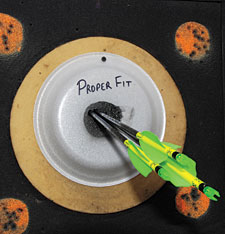 This photo shows the super tight 20-yard group John Dudley was able to shoot after confirming that his nocks were properly fit. |
There is also a fine line between nocks that fit perfectly and nocks that are too loose. If your nock is too loose, you will quickly get frustrated with keeping it on the string. To be honest, a nock that fits loosely still will shoot with very good grouping results. Many competition shooters actually prefer lightly fitting nocks because the reduced restriction does have good results. As a bowhunter, however, this isn't a wise choice because an arrow that easily falls off the string will cost you someday.
The String Tension Factor
When it comes to maximizing accuracy with nock fit, string tension is also a big factor. String tension is how tight your bowstring is when the bow is at rest. The looser the string tension, the further forward the arrow will pull the string before the nock releases. And the longer the arrow is connected to the string, the more likely you are to make a negative impact. If your arrow fit is too tight to the serving, this will only magnify the problem! As a rule of thumb, a bow's string tension will be looser with lower draw weights. Reduced string tension is also common on bows where the limbs are backed out to reduce poundage. This is especially true on parallel-limb bows. The more the limbs are backed out, the quicker the string loses tension in the resting position. If you combine a loose string with an overly tight nock fit, you are set up for inaccurate results.
If you recognize the string tension is noticeably weak on your bow, then consider an aftermarket string suppressor device and make sure your nock fit is good. Then, you should have no problems maximizing your accuracy. If you are in the market for a new bow, I urge you to buy one that allows you to shoot the peak weight you are most comfortable with. For example, if you are likely to shoot around 60 pounds, buy a bow that is built for a 60-pound maximum pull. This prevents you from having to reduce the weight to the bottom end of the limb's range, which will reduce string tension. Most retailers are good about stocking lower poundage limbs, so be
sure to consider this on your next purchase.
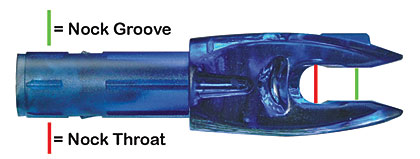 The groove on a nock (green) is slightly narrower than the throat (red). This is designed to hold the arrow securely on the string while still allowing enough room for the string to rotate freely without turning the arrow, which can compromise accuracy. |
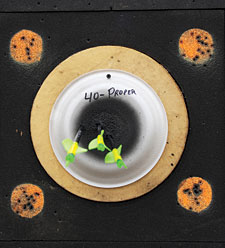 This photo shows the arrow group John Dudley shot at 40 yards with properly fit nocks. |
Pinch Problems
In addition to the fit of the nock onto the serving, there is another fitting to consider -- the actual nock points or nocking loop on the string. The spacing of your loop or nock points and how they squeeze the arrow nock plays a role in performance equal to that of nock fit. This is what is commonly referred to as nock pinch. Years and years ago, this didn't seem to play near the role it does now. This is for several reasons, including the fact many people used fingers instead of a mechanical release and bows were much longer in axle-to-axle length. A bow's axle-to-axle length, brace height and the length of your draw all factor into the string angle at a full draw. The more severe the angle, the more severely your nock sets or nocking loop will pinch the arrow's nock.
Nocking loops and nocking points that are tied into place with serving thread are typically more forgiving than brass nock sets. The synthetic fiber is much more flexible than brass, so you have some room to give. I always leave one half to one millimeter of space between my arrow nock and my nocking points or nocking loop.
If you commonly have problems with your arrow falling off the string at full draw or when you let down, you most likely are having issues with nock pinch. In addition, if you constantly battle with your arrow wanting to come off your rest when getting to full draw, you are most certainly having issues with nock pinch. When the nock points or nocking loop pinch too tightly on the arrow at full draw, it tends to lift the arrow off the arrow rest and/or push it to one side. This is a problem on level ground but even more of a problem when shooting from a treestand.
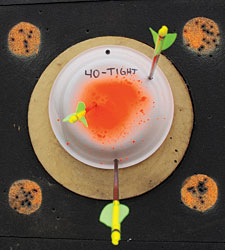 This photo shows the arrow group John Dudley shot at 40 yards with nocks pinched too tightly by the nocking loop. |
To make sure you do not have excessive nock pinch, do this simple test: remove the tip from your arrow and pull your bow back to full draw. If your arrow does not stay seated perfectly on your rest, then you definitely have excessive nock pinch. Take a look at the accompanying photos. One photo shows the arrow sitting perfectly on the rest and the other shows that when the nock is pinched too tight, the arrow will lift off the rest. Do the test while pointing the bow downward, as if you were shooting from a treestand. Again, if the arrow comes up off the rest, your nock is being pinched too tightly. If your nock pinch is too much, the simple fix is to make a small increase in the width of your nock points or nocking loop. I want to stress it may only take one millimeter to make sure you are set up correctly. It is important to not go to the extreme of having too much space between nocking points, as this could also have negative affects on accuracy if there is vertical slope in your nocks while at full draw.
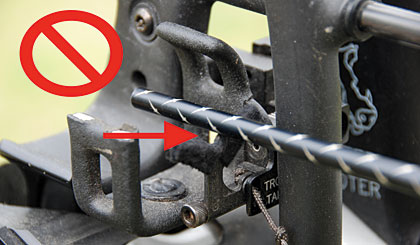 If your nock is pinched too tightly by your nocking loop or nocking points, the arrow will have a tendency to lift up and off the rest at full draw. Increasing the space inside your nocking loop or between your nocking points by as little as one millimeter could be all that's needed to remedy the problem. |
Through years of competing and hundreds of thousands of arrows, I have learned how much the small things matter when it comes to archery tackle. Something as simple as your serving thread and the piece of plastic connected to it could be the determining factor in whether you fill your tag or eat it. I took what I learned from my competitive career and applied it to my hunting tackle, and the difference has been amazing. There is no doubt why bowhunting greats such as Randy Ulmer continually have more success in the woods. He applies all the knowledge gleaned from years of tuning bows for the toughest of competitions into the camo bows he takes to the field.
Taking time to understand how bows and arrows work together has not only helped bowhunters become better shots but also helped them to be more confident in the field. If you do the same, the results will speak for themselves!
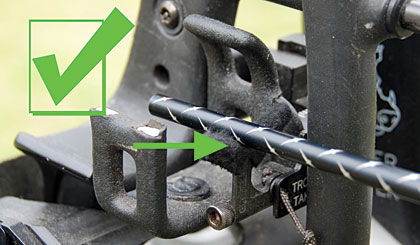 Properly fit arrow nocks will keep your arrows securely on the rest's launcher at full draw. If your nocks are pinched too tightly, the arrow will tend to rise up off the rest during the draw cycle and(or) move sideways at full draw. Nock sets that are tied with serving thread are typically more forgiving than brass nock sets. |
